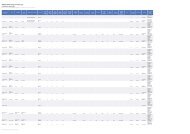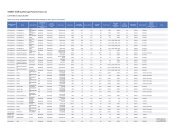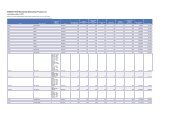Cadenza Document - Energy Star
Cadenza Document - Energy Star
Cadenza Document - Energy Star
You also want an ePaper? Increase the reach of your titles
YUMPU automatically turns print PDFs into web optimized ePapers that Google loves.
Definitions for Displays Product Listing Column Headers<br />
Column Header<br />
ENERGY STAR Partner<br />
Brand<br />
Model Name<br />
Model Number<br />
Additional Model<br />
Information<br />
Definition<br />
An organization that signed a Partnership Agreement with EPA to<br />
manufacture or private label ENERGY STAR qualified products.<br />
An identifier assigned by the manufacturer or private labeler to a<br />
product or family/series of products for sales and marketing<br />
purposes.<br />
An identifier assigned by the manufacturer or private labeler to a<br />
product or family/series of products for sales and marketing<br />
purposes.<br />
A distinguishing identifier, usually alphanumeric, assigned to a<br />
product by the manufacturer or private labeler.<br />
This column includes for the qualified model or family, family<br />
members, additional model names, model numbers and other<br />
identifying information associated with a product or family/series<br />
of products for sales and marketing purposes. Other identifying<br />
information includes, but is not limited to, SKUs, UPC codes, retail<br />
numbers, and/or descriptions of models included/not included in<br />
the reported Model Family.<br />
Display Type<br />
The 4 types of Displays eligible for ENERGY STAR certification<br />
are:<br />
1) Digital Picture Frame: An electronic device, typically with a<br />
diagonal screen size less than 12 inches, whose primary function<br />
is to display digital images. It may also feature a programmable<br />
timer, occupancy sensor, audio, video, or bluetooth or wireless<br />
connectivity.<br />
2) Professional Display/Signage: An electronic device typically<br />
with a diagonal screen size greater than 12 inches and a pixel<br />
density less than or equal to 5,000 pixels/in2. It is typically<br />
marketed as commercial signage for use in areas where it is<br />
intended to be viewed by multiple people in non-desk based<br />
environments, such as retail or department stores, restaurants,<br />
museums, hotels, outdoor venues, airports, conference rooms or<br />
classrooms.<br />
3) Monitor: An electronic device, typically with a diagonal screen<br />
size greater than 12 inches and a pixel density greater than 5,000<br />
pixels per square inch (pixels/in2), that displays a computer's user<br />
interface and open programs, allowing the user to interact with the<br />
computer, typically using a keyboard and mouse.<br />
4) Enhanced-Performance Display: A computer monitor that has<br />
all of the following 14 features and functionalities: (a) A contrast<br />
ratio of at least 60:1 measured at a horizontal viewing angle of at<br />
least 85°, with or without a screen cover glass; (b) A native<br />
resolution greater than or equal to 2.3 megapixels (MP); and, (c) A<br />
color gamut of at least sRGB as defined by IEC 61966 2-1.

















